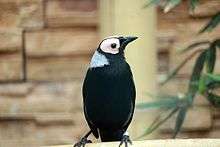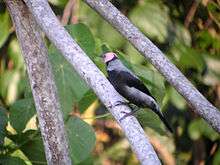Coleto
The coleto (Sarcops calvus) is a starling species (family Sturnidae) in the monotypic genus Sarcops. It is endemic to the Philippines. Its natural habitats are subtropical or tropical dry forest, subtropical or tropical moist lowland forest, and subtropical or tropical moist montane forest. In Central Visayas, this bird is commonly known as the sal-ing.[1]

| Coleto | |
|---|---|
 | |
| Scientific classification | |
| Kingdom: | Animalia |
| Phylum: | Chordata |
| Class: | Aves |
| Order: | Passeriformes |
| Family: | Sturnidae |
| Genus: | Sarcops Walden, 1875 |
| Species: | S. calvus |
| Binomial name | |
| Sarcops calvus | |
| Synonyms | |
|
Gracula calva Linnaeus, 1766 | |
In 1760 the French zoologist Mathurin Jacques Brisson included a description of the coleto in his Ornithologie based on a specimen collected in the Philippines. He used the French name Le merle chauve des Philippines and the Latin Merula Calva Philippensis.[2] Although Brisson coined Latin names, these do not conform to the binomial system and are not recognised by the International Commission on Zoological Nomenclature.[3] When in 1766 the Swedish naturalist Carl Linnaeus updated his Systema Naturae for the twelfth edition, he added 240 species that had been previously described by Brisson.[3] One of these was the coleto. Linnaeus included a brief description, coined the binomial name Gracula calva and cited Brisson's work.[4] The specific name is from Latin calvus "bald" or "without hair".[5] This species is now the only member of the genus Sarcops that was introduced by the English ornithologist Authur Walden in 1875.[6] The name combines the Ancient Greek words sarx, sarkos "flesh" and ōps, ōpos "face" or "complexion".[7]
Three subspecies are recognised:[8]
- S. c. calvus (Linnaeus, 1766) – north Philippines
- S. c. melanonotus Ogilvie-Grant, 1906 – central and south Philippines
- S. c. lowii Sharpe, 1877 – Sulu Archipelago (southwest Philippines)
References
- BirdLife International (2012). "Sarcops calvus". IUCN Red List of Threatened Species. 2012. Retrieved 26 November 2013.CS1 maint: ref=harv (link)
- Brisson, Mathurin Jacques (1760). Ornithologie, ou, Méthode contenant la division des oiseaux en ordres, sections, genres, especes & leurs variétés (in French and Latin). Volume 2. Paris: Jean-Baptiste Bauche. pp. XXX, Plate 26 fig 2. The two stars (**) at the start of the section indicates that Brisson based his description on the examination of a specimen.
- Allen, J.A. (1910). "Collation of Brisson's genera of birds with those of Linnaeus". Bulletin of the American Museum of Natural History. 28: 317–335.
- Linnaeus, Carl (1766). Systema naturae : per regna tria natura, secundum classes, ordines, genera, species, cum characteribus, differentiis, synonymis, locis (in Latin). Volume 1, Part 1 (12th ed.). Holmiae (Stockholm): Laurentii Salvii. p. 164.
- Jobling, J.A. (2018). del Hoyo, J.; Elliott, A.; Sargatal, J.; Christie, D.A.; de Juana, E. (eds.). "Key to Scientific Names in Ornithology". Handbook of the Birds of the World Alive. Lynx Edicions. Retrieved 12 May 2018.
- Walden, Arthur (1875). "A list of the birds known to inhabit the Philippine Archipelago". Transactions of the Zoological Society of London. 9: 125-252 [205].
- Jobling, J.A. (2018). del Hoyo, J.; Elliott, A.; Sargatal, J.; Christie, D.A.; de Juana, E. (eds.). "Key to Scientific Names in Ornithology". Handbook of the Birds of the World Alive. Lynx Edicions. Retrieved 12 May 2018.
- Gill, Frank; Donsker, David, eds. (2018). "Nuthatches, Wallcreeper, treecreepers, mockingbirds, starlings, oxpeckers". World Bird List Version 8.1. International Ornithologists' Union. Retrieved 12 May 2018.
External links


